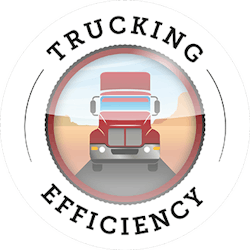Two-truck platooning a viable method for reducing fuel consumption
Two-truck platooning – an emerging technology designed to boost fuel economy performance for tractor trailers engaged in long- and regional-haul applications – is “showing real promise as a fuel-saving technology, even when considering the actual performance in real-world use,” says Mike Roeth, executive director, NACFE, operation lead, Trucking Efficiency. Once the trucks have moved into close following distances, all of the engaged vehicles receive a significant fuel economy boost thanks to increased aerodynamic efficiencies.
Platooning combines existing commercial vehicle safety technology with emerging vehicle-to-vehicle communications and autonomous vehicle control technology to electronically “tether” tractor trailers together in a convoy formation at highway speeds. Once a platoon of trucks is established, the vehicles’ safety systems work in unison to draw the trucks together at significantly reduced following distances to overcome each vehicle’s inherent aerodynamic drag.
In platooning, the lead vehicle, which bears the brunt of the aerodynamic load, typically sees only a modest fuel economy boost, Roeth says. However, the trailing truck in a platoon, which is now operating in a low air pressure aerodynamic “sweet spot,” can see significant increases in fuel economy performance at highway speeds. Moreover, overall fleet operations remain largely intact in terms of vehicle routing and operations.
Latest report
That is the overall finding of the just-released Trucking Efficiency Confidence Report: Two-Truck Platooning. The report details what platooning entails, plus explores some of the perceived and real challenges presented by platooning, such as driver acceptance, platoon integrity, system security and amount of time platooning.
Trucking Efficiency (www.truckingefficiency.org) is a joint initiative of NACFE and the Carbon War Room (www.carbonwarroom.com)) that aims to double the efficiency of the North American trucking fleet by eliminating barriers to information, demand and supply.
Founded in 2010, NACFE works to drive the development and adoption of efficiency-enhancing, environmentally-beneficial and cost-effective technologies, services and methodologies in the North American freight industry by establishing and communicating credible and performance-based benefits.
Real-world factors
The potential fuel consumption savings versus an isolated single vehicle varies depending on the separation distance of the trucks, says the report. However, a 40’ to 50’ following distance can lead to 4 percent average savings over the two trucks in real-world operating conditions, after accounting for traffic, terrain and time when equipped trucks will not be operating in a platoon.
However, real-world factors such as congestion, terrain, weather and road construction will reduce these savings, Roeth says, so fleets will have to estimate this reduction depending upon the routes on which they plan to operate the trucks. A reasonable estimate would be a reduction of about a quarter of the savings, but very little data exists for this prediction.
A fleet must also apply the percentage of operating time that the truck equipped with platooning will actually be involved in a platoon. NACFE research suggests will be less than 100 percent, he says. If that were 75 percent, then the real-world, expected savings would be on the order of 4 percent average for both trucks.
Even if a truck is platooning 50 percent or less, it “still represents significant potential improvement in fuel use” for the following vehicle in a platoon, points out Roeth.
First time
Trucking Efficiency Confidence Report: Two-Truck Platooning is the first Trucking Efficiency Confidence Report on an emerging technology. It is also the first of two reports on two-truck platooning
Despite being a relatively new practice, there is enough data available to bring a foundational understanding of two-truck platooning, and in turn, to advise the industry on how to eliminate or mitigate the challenges to adoption identified in the report, says Roeth. Also, the technologies used for two-truck platooning are fundamental to the longer-term autonomous trucking initiative.
Included in the report are industry recommendations for two-truck platooning. There is also a simple payback calculator to evaluate the total cost of ownership of adopting two-truck platooning.
Both the full Confidence Report and an executive summary of it can be found online at http://truckingefficiency.org/operational-practices/two-truck-platooning
Confidence Reports
Trucking Efficiency Confidence Reports, which are publicly available, assess current technologies, discuss challenges and best practices for their adoption, plus provide figures on performance gains and payback periods.
They are available for free online at http://truckingefficiency.org.
About the Author

